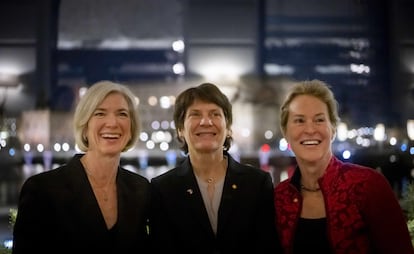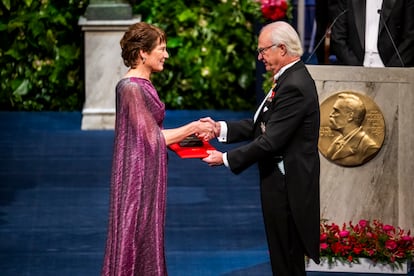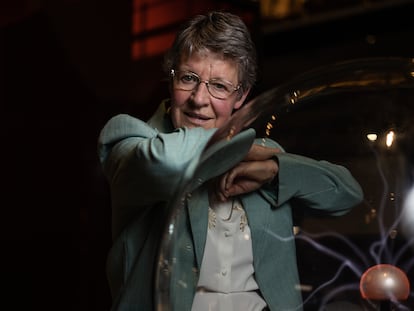Carolyn Bertozzi, Nobel laureate in chemistry: ‘We’ve invented a miniature lawn mower for cancer cells’
The Stanford researcher has devised a new way of looking at and modifying cells by focusing on sugars. In her rebellious youth, she played in a rock band with the guitarist of Rage Against the Machine

As a college student, Carolyn Bertozzi worked as a cashier at a bakery and mowed lawns. Then, she played the keyboard in a rock band with Tom Morello, the guitarist who eventually went on to found the band Rage Against the Machine. Their group was called Bored of Education, but Bertozzi wasn’t bored at all. The rebellious young woman who once played covers of AC/DC and Def Leppard just won the Nobel Prize in Chemistry. Now 56, the researcher has invented a new way of seeing the world and modifying it.
“Human cells, including cancer cells, are covered with sugars,” explains Bertozzi, a researcher at Stanford University. The Boston-born scientist encourages us to imagine that we are flying in a microscopic airplane over the landscape of a cell’s surface. “There’s giant redwood trees that are tall and stiff. There [are] trees that are swaying in the wind like the willows. There’s little shrubs, there’s [a] little grass. And all of those…are made up of sugars, all these complex carbohydrates with different shapes and sizes. And it’s not random at all. It’s a specific pattern of vegetation [in each cell] … For example, what you see on a muscle cell is different from what you see in a blood cell, [which] is different [from] what you see on a neuron…All the different cell types in your body have different patterns of sugars,” Bertozzi says animatedly, as if she were really flying over a microworld. When she finds a cancer cell on this mental journey, she says she stops seeing a forest and sees a fearsome jungle instead.
In the past, we didn’t have the tools to observe these enigmatic sugars, so over two decades ago, Bertozzi created a new way of doing chemical reactions – called bioorthogonal chemistry – with molecules that only interact with each other; they don’t interfere with the myriad of other substances in a cell. “[It’s like a movie, when] one person walks in [this] side of the room, the other person walks in that side. It’s crowded with people everywhere, and somehow their eyes meet, and it’s like a match…And everyone [else] just disappears and they find each other and connect. And that’s exactly how these reactions work,” she tells us via videoconference from her home in Stanford. The researcher developed this method to attach fluorescent molecules to sugars in living animals, so that they could be visualized and studied, but her technique has proved revolutionary in addressing a multitude of scientific challenges. Her own team is using it to try to cure cancer.
Question. You say that this forest of sugars on the surface of cells is a language. What do you mean by that?
Answer. Sometimes I think of them as a QR code… So other cells, like immune cells, can come along and scan those sugars and see what [they] look like. And if the immune cells see… a bad pattern of sugars, they might kill that cell because they notice something wrong….But, as a survival tactic, [cancers will] create a pattern of sugars that can confuse the immune cells and allows the cancer cells to escape recognition by your immune system, which is a hallmark of disseminated cancers: the tumors have found a way to sneak around and not get recognized by your immune system.
Q. You also say that sialic acid is “one of the most important sugars of our time.” Why is that?
A. Our immune cells can scan the pattern of sialic acids. And that is a language that tells the immune cell whether it’s a healthy cell or a damaged cell. And one of the immune escape mechanisms of cancers is to overproduce these sialic glycans – the glycans with the sialic acids on the top – because they can interact with receptors on the immune cell [and] basically tell the immune cell that this is a totally normal, healthy cell, [essentially, they tell them to] “go away, [there’s] nothing to see here”…That’s why it’s so important.
Q. You have founded 11 start-up companies. One of them, Palleon Pharmaceuticals, is testing an experimental drug in cancer patients. You compare it to a lawnmower in that it cuts the sugars with which cancer cells camouflage themselves.
A. Yes. It kind of cuts the grass and prunes the trees [to allow the immune system to recognize the malignant cells and destroy them].
Q. In fact, as a teenager you worked mowing lawns. Maybe that was a source of inspiration for the analogy.
A. I have mowed many lawns in my life…When I was a kid, my family chore was to mow the lawn… and we had a big yard… I had a boyfriend in high school, and we decided to start our own business…People would hire us to mow lawns and walk dogs and water plants and whatever needed to be done.
Q. And, ironically, you ended up inventing an anti-cancer lawn mower.
A. Yeah. It’s a little miniaturized lawn mower for cancer cells… They’re enrolling patients with five different cancer types…There’s pancreatic, ovarian, colon, melanoma or skin cancer and lung cancer…It’s a phase one study, it helps us learn about how well-tolerated the doses are and make sure the drug is safe.
Q. So success is not guaranteed?
A. Oh, no, of course [not]…In the world of drug development, something like nine out of 10 clinically tested drugs fail. So, there’s a 90% failure rate [for] drugs that have looked amazing in animals… I’m very bullish about this, but it would be very naïve to say [that it will work] … it doesn’t really work until you have human clinical data from enough patients in a phase two study.
Q. The pharmaceutical industry has ignored these sugars for decades.
A. They’re still ignoring them…I mean, to be fair to the pharma industry, there were brief periods of time when they did pay attention to science. One of those periods of time was in the early 1990s, between 1989 and 1994, 1995. That was a period of time where there actually was a lot of interest in certain receptors of the immune system that are involved in inflammation and that bind to carbohydrates… [But] most of those programs didn’t work out. And then they lost interest and jumped to the next exciting thing…Attention spans are short in the pharma industry. If things don’t work quickly and if a new thing isn’t panning out right away, companies rarely have enough attention span to stay with it for long enough to solve problems that need to be solved…[But] if we’re right about sialic acids in cancer immunotherapy and [they’re] validated as therapeutics, if we’re right about that, that will catalyze a big resurgence of interest for sure.
Q. A few months ago, you stated in Stanford Magazine that “if we are successful, history will look back on this field of research and wonder how people could have been so blind.”
A. Yeah. Like anything, hindsight is full of clarity. But I think that’s true because to my mind… it’s hiding in plain sight… In my mind, these are really important targets for cancer immunotherapy hiding in plain sight. Everybody should be working on them, but they’re not...I hope we’re right.
Q. Since 1901, 189 people have won the Nobel Prize in Chemistry, but only eight of them, or 4%, have been women. What do you think about that?
A. They’re amazing women. I know most of them. Five of us are alive today.... Three of them are American. And all three of us are in California. And we all know each other very well…I met Jennifer Doudna, inventor of the CRISPR technology, [and] Frances Arnold, who invented the concept of directed evolution for enzymes. These are amazing, epic scientists, once-in-a-generation types of scientists… and there are many [more] …one could have justified giving Nobel Prizes to. That’s been true for decades.

Q. So why are there so few female Nobel Prize winners? Is it sexism on the part of the Nobel Jury?
A. I don’t really know because the Nobel process happens behind closed doors…. But everyone knows it’s a problem. Every year when there’s Nobel Prizes and they’re all men, there’s a lot of complaining, and people [are] upset. The Nobel committee would like to have a deeper pool of nominees that they can analyze and choose from, but not anybody can do such a nomination. They invite nominations from existing laureates, and if those nominators are not diverse, then you’re less likely to get a diverse group of nominees. The Nobel committee actually hired a consulting firm to help them change their process, to get a deeper, broader, more diverse group of people into the pool. And the suggestions that were made to them [were] simple things. For example, try to diversify the people you invite to nominate to start with. And then rather than asking each of those university presidents or those Nobel laureates for one name, ask for three…so, they change[d] this. They ask people for three names instead of one.
Q. Why three?
A. When you ask a person who’s the one person you would nominate, they almost always think of an older white man because they have unconscious bias. But if you ask them for three names, it’s harder for them to give all older white men because then they look at that letter like, ‘wait a minute…I should be able to get a woman in there if I have three slots.’ There’s a psychology, I guess, to that…Now, they ask people for three names, and they started getting more women. Chemistry is looking good because there’s eight of us. Not many, but four from the last four years. I could sit here and throw out 20 names of women who are certainly as deserving as me or any of the men that received Nobel Prizes recently. They just need to be nominated.
Q. Months before you won the Nobel Prize, you said that being a woman has hurt you more in your scientific career than being a lesbian.
A. In terms of challenges that you face in your academic career, yes, I would say that. In other ways, it depends on the context. There are places in the world where being gay is still criminalized. But in academic science and in my world of chemistry, I would say that the unconscious biases against women for me were more difficult, more challenging than the anti-gay biases that I had to deal with.

Q. Nobel laureates usually travel all over the world, because everyone wants them to give talks, but there are almost 70 countries that criminalize gay sex acts between adults. In some places, like Saudi Arabia and Qatar, the punishment can even be the death penalty. Qatar just hosted the World Cup; would you go there or to Saudi Arabia to give a lecture?
A. I can’t go. Not just because of me and my safety, which is big, but I have kids. I can’t go to a place where it’s not safe for me. [There’s] too much at stake.
Q. There has been more diversity among this year’s Nobel laureates. You are openly lesbian and Svante Pääbo, the winner of the Nobel Prize for Medicine, also speaks openly about his bisexuality. Is something changing at the Nobel Prizes?
A. It’s not so much that the Nobel Prize has changed. I think society has changed to the point where I was allowed to have a job and be out as a lesbian. I think about this all the time because I realize my privilege. If I had been born even just 10 years earlier, I don’t think we’d be having this conversation. In the US, I don’t think I would have been hirable. I wouldn’t have been able to be an out lesbian and get a job. It was too much of a stigma, I would have had to be in the closet. In the 1950s, there were witch hunts to root out the homosexuals from government jobs and fire them and blackball them and criminalize them.
Q. Last month, the United States passed a law to protect same-sex marriage. You just won the Nobel Prize, but some people in your own country don’t think you should be able to get married.
A. Yeah. I mean, in Qatar, I’m not good enough to be alive. Oh, I’m sure they’ll be happy to take my cancer drugs when they get sick... But [they’d] put me on death row.
Q. The first Muslim scientist to win a Nobel Prize, Pakistani physicist Abdus Salam, was a polygamist and attended the ceremony with his two wives in Stockholm in 1979. It has taken over 40 years to see a lesbian scientist attend the reception with her partner.
A. I’m the only Nobel laureate who’s ever gone with a same-sex partner that I know of. There’s other gay Nobel laureates, but they’re [in] literature and peace, not in the sciences. And there have been some that were openly gay. So there I was with my same-sex partner, and nobody blinked. Nobody was weird. It was totally normal. So, I can now tell the next queer laureate, “Go ahead. Bring your same sex partner. It’s totally cool.”
Q. At the Nobel ceremony banquet, you said that “chemists are dreamers.” That’s not how teenage students usually think about it.
A. I know, but they are. Tell your kids [about] chemistry…I’m a synthetic chemist, which means we make molecules that don’t exist in the world until we make them. We dream up structures because we have ideas [about what will happen if] we make a molecule that looks like this. Maybe it’ll have a cool new color, a cool new taste. Maybe it will cure your disease. Maybe it will make a new plastic that can be degraded in the environment without polluting the world. We invent chemicals that have these cool properties, and we bring them to life; we basically create new forms of matter that never existed before. And they came from our heads. So, that’s what I mean by chemists are dreamers.
Sign up for our weekly newsletter to get more English-language news coverage from EL PAÍS USA Edition
Tu suscripción se está usando en otro dispositivo
¿Quieres añadir otro usuario a tu suscripción?
Si continúas leyendo en este dispositivo, no se podrá leer en el otro.
FlechaTu suscripción se está usando en otro dispositivo y solo puedes acceder a EL PAÍS desde un dispositivo a la vez.
Si quieres compartir tu cuenta, cambia tu suscripción a la modalidad Premium, así podrás añadir otro usuario. Cada uno accederá con su propia cuenta de email, lo que os permitirá personalizar vuestra experiencia en EL PAÍS.
¿Tienes una suscripción de empresa? Accede aquí para contratar más cuentas.
En el caso de no saber quién está usando tu cuenta, te recomendamos cambiar tu contraseña aquí.
Si decides continuar compartiendo tu cuenta, este mensaje se mostrará en tu dispositivo y en el de la otra persona que está usando tu cuenta de forma indefinida, afectando a tu experiencia de lectura. Puedes consultar aquí los términos y condiciones de la suscripción digital.
More information
Archived In
Últimas noticias
Most viewed
- Sinaloa Cartel war is taking its toll on Los Chapitos
- Oona Chaplin: ‘I told James Cameron that I was living in a treehouse and starting a permaculture project with a friend’
- Reinhard Genzel, Nobel laureate in physics: ‘One-minute videos will never give you the truth’
- Why the price of coffee has skyrocketed: from Brazilian plantations to specialty coffee houses
- Silver prices are going crazy: This is what’s fueling the rally










































